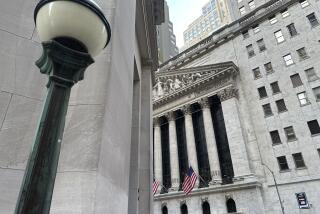Yields’ Drop Could Be Just the Beginning of Steep Decline
- Share via
Is the bond market heralding a steep decline in interest rates ahead?
Tuesday’s rally pulled long- and short-term yields down to their lowest levels since late July.
The 10-year Treasury note yield, for example, fell to 6.11% from 6.29% on Monday and now is the lowest since it briefly touched 6.01% on July 31.
The yield on the one-year Treasury bill ended at 5.46%, down from 5.53% on Monday and also the lowest since July 31.
It’s dangerous to read too much into one day’s market action, of course. The rush to lock in yields Tuesday was partly technical, related to some investors’ recent short sales of Treasury securities made in tandem with their purchases of corporate bonds.
Those transactions aren’t worth explaining, but suffice to say that some of those short-sellers were buying back Treasury issues Tuesday, helping to stoke the rally.
Still, the trigger for the buying wave was data indicating no material change in the “nirvana” economy of the last two years: August consumer inflation remained amazingly subdued, despite the economy’s healthy pace of growth.
Although U.S. interest rates have been moving erratically lower since late 1994, many Wall Street pros have argued that long-term bond yields remain far too high relative to current inflation, which is the lowest in 30 years.
The “core” rate of consumer price inflation has been 2.3% over the last 12 months. That means the real, or after-inflation, rate of return on the 10-year T-note is a substantial 3.8%. On the 30-year T-bond, which yielded 6.4% on Tuesday, the real return is 4.1%.
In the long run, many economists argue, long-term bonds should provide real yields of just 2% or so. That implies Treasury yields should be much lower.
The stock market has understood this, some experts say, and that’s why stock prices have risen so dramatically since 1994.
Ned Riley, chief investment officer at BankBoston’s private bank unit in Boston, says he has been arguing that equity investors are pricing stocks based on where interest rates should be.
In other words, the stock market has correctly forecast that inflation would remain under control, while the bond market has continued to exhibit a high level of suspicion about inflation, fearing that it could resurge at any moment.
That suspicion has been well-grounded. After all, the Federal Reserve Board raised short-term interest rates by a quarter point in March, signaling that it, too, believed inflation could revive with strong economic growth.
But since then the economy has continued to advance while inflation has been docile. Fed Chairman Alan Greenspan has acknowledged in recent months that the Fed might have to rethink its ideas about how fast the economy might be able to grow without triggering higher inflation.
Tuesday’s rush to buy bonds could suggest that more people are losing their fear of a rebound in inflation, and are eager to lock in yields before they go far lower.
Moreover, because so many bond investors have been cautious in terms of what they own and how much they own, it’s conceivable that a change in psychology about where yields should be could spur a much bigger buying wave soon.
“If people have been nervous [about locking in yields], they could be behind the curve now,” said Kathleen Gaffney, co-manager of the Loomis Sayles Bond mutual fund in Boston.
She believes that the 30-year T-bond yield could fall to 6% by year’s end. That would be the lowest since early 1996.
The bond market also has a lot of other things going for it now. In fact, it has been an island of relative tranquillity in recent weeks, with yields stuck in a very narrow range while the stock market has swung wildly.
What’s been helping bonds:
* The economic turmoil in Southeast Asia, which has spurred a “flight to quality,” driving some money out of Southeast Asian investments and into Treasury issues, bond traders say.
* The drop in the federal deficit, which has meant lower Treasury borrowing needs, limiting the supply of new bonds.
* U.S. yields look attractive relative to bond yields in many other countries. Japanese 10-year government bond yields have fallen to a record low 1.95%, as the Japanese economy appears vulnerable to falling into a new recession.
Even compared with many European countries, U.S. yields are high. The yield on 10-year German government bonds is 5.58%, versus 6.11% on 10-year U.S. notes.
* Rumors that some savvy investors, including Warren Buffett, have been loading up on bonds while selling stocks.
But are U.S. bonds really a better bet than U.S. stocks now? If, with the stock market’s gains since 1994, your portfolio has become too heavily invested in stocks for your comfort level, a “re-balancing” that raises the bond portion of your investment mix while lowering the stock portion may make long-term sense.
Even so, many experts point out that if the bond market continues to rally in the current economic environment, it will almost certainly be good for stocks as well.
And some warn that the economy’s pace of growth is bound to translate into slightly higher inflation in 1998--enough so to put an abrupt end to the bond market rally, while many stocks could continue to do well.
Peter Canelo, investment strategist at Morgan Stanley Dean Witter in New York, expects bond yields to fall in coming weeks. But he says he’d sell into that rally.
“The U.S. economy is accelerating,” Canelo says. Buying bonds at a time like this, he argues, is far too brave a bet to make.
More to Read
Inside the business of entertainment
The Wide Shot brings you news, analysis and insights on everything from streaming wars to production — and what it all means for the future.
You may occasionally receive promotional content from the Los Angeles Times.










